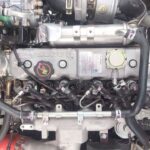The Isuzu truck gear shift, seemingly simple, plays a pivotal role in controlling and operating the vehicle. Understanding the symbols on the gear shift not only helps you drive safely but also optimizes performance and extends the lifespan of your Isuzu truck. This article from Xe Tải Mỹ Đình, a leading source for Isuzu trucks, provides a comprehensive overview of the Isuzu truck gear shift, from its structure and symbol meanings to detailed usage and maintenance instructions.
 Close-up of a modern Isuzu truck gear shift
Close-up of a modern Isuzu truck gear shift
Isuzu Truck Gear Shift Structure and Symbol Meanings
The Isuzu truck gear shift is designed to allow the driver to easily select different operating modes of the vehicle. Basically, whether it’s a manual or automatic transmission, the gear shift includes main symbols such as forward gears, reverse gear, and park mode. However, depending on the type of transmission and specific Isuzu model, the symbols and functions may vary.
1. Manual Gear Shift in Isuzu Trucks
The manual gear shift in Isuzu trucks, like other manual vehicles, allows the driver to fully control the speed and traction of the vehicle by shifting gears.
Basic symbols on the manual gear shift:
- O (Mo/Neutral): Neutral position, disconnecting the transmission from the engine to the wheels. Commonly used when stopping at red lights, starting the engine, or when the vehicle needs to be pushed/pulled.
- 1, 2, 3, 4, 5,… (Forward Gears): Increasing sequential numbers indicating different forward gear levels. Lower numbers correspond to greater traction and lower speed, suitable for starting, climbing hills, or carrying heavy loads. Higher numbers correspond to higher speed and reduced traction, used when traveling on highways or flat roads.
- R (Reverse): Reverse gear, used to move the vehicle backward. It is important to only shift into R when the vehicle has come to a complete stop.
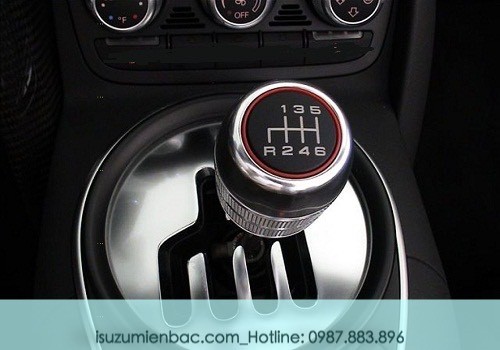 Diagram showing the gear shift pattern of a common Isuzu truck manual transmission
Diagram showing the gear shift pattern of a common Isuzu truck manual transmission
Gear Shift Pattern: The gear shift pattern is usually printed directly on the gear shift knob or the control panel near the gear shift. Typically:
- Odd numbers (1, 3, 5…) are usually located in the top row.
- Even numbers (2, 4, 6…) are usually located in the bottom row.
- The O (Mo) position is located in the center.
- The R (Reverse) position can be located in various places depending on the vehicle model, either in the top row, bottom row, or the same row as Mo.
Important Note: Before operating an Isuzu manual truck, take the time to carefully observe the gear shift pattern to familiarize yourself with the positions of the gears, especially reverse (R), to avoid confusion when operating the vehicle.
2. Automatic Gear Shift in Isuzu Trucks
The automatic gear shift in Isuzu trucks makes driving easier and more comfortable, especially in heavy urban traffic. The automatic transmission will automatically shift gears based on the vehicle’s speed and load.
Basic symbols on the automatic gear shift:
- P (Park): Park mode, locks the transmission and prevents the vehicle from moving. Always shift into P when parking the vehicle, especially on slopes.
- R (Reverse): Similar to reverse gear on a manual vehicle, used to move the vehicle backward.
- N (Neutral): Similar to Mo on a manual vehicle, disconnects the transmission. Used when stopping at red lights for a short time or when the vehicle needs to be towed.
- D (Drive): Normal driving mode. The automatic transmission will automatically select the appropriate gear to move forward.
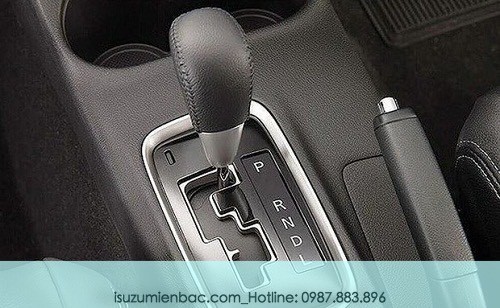 Symbols on the automatic gear shift of an Isuzu truck
Symbols on the automatic gear shift of an Isuzu truck
Additional symbols on the automatic gear shift (depending on the model):
- M (Manual) or (+/-): Manual mode on an automatic vehicle. Allows the driver to manually shift gears up and down as desired, providing a more active driving experience, similar to a manual vehicle.
- OD (Overdrive): Overdrive mode. Commonly used when wanting to accelerate quickly to overtake another vehicle or when going downhill to slow down using the engine.
- L (Low): Low gear, used when needing high traction at low speed, such as when carrying heavy loads, climbing hills, or descending slopes.
- B (Brake): Brake gear, similar to L, used to slow down the vehicle when descending slopes without using the brakes frequently, helping to increase safety when going downhill.
- S (Sport): Sport mode, helps the vehicle accelerate faster and provides a more responsive throttle.
- D1, D2, D3… (Drive 1, Drive 2, Drive 3…): Limited gear levels, usually used when moving at slow speeds, on difficult roads, or when descending steep slopes, helping to control the vehicle’s speed and traction.
Paddle Shifters: Some high-end Isuzu automatic trucks are equipped with paddle shifters on the steering wheel, allowing the driver to shift gears quickly and conveniently without taking their hands off the wheel.
How to Operate and Shift Gears Correctly in an Isuzu Truck
Shifting gears correctly in an Isuzu truck is an important factor in ensuring safe, smooth, and fuel-efficient vehicle operation.
1. How to Shift Gears in an Automatic Isuzu Truck
Shifting gears in an automatic Isuzu truck is relatively simple:
- Start the engine: Make sure the vehicle is completely stopped and the gear shift is in the P position. Depress the brake pedal and turn the key or press the start button to start the engine.
- Select gear: While still holding the brake pedal, move the gear shift to the desired position (D to move forward, R to reverse, N to stop temporarily).
- Move: Release the parking brake (if engaged), slowly release the brake pedal and switch to lightly pressing the accelerator pedal to move the vehicle. Adjust the accelerator pedal to control the speed.
2. How to Shift Gears in a Manual Isuzu Truck
Shifting gears in a manual Isuzu truck requires coordination between the hands and feet:
- Start the engine: Make sure the vehicle is completely stopped, the gear shift is in the O (Mo) position, and the parking brake is engaged. Fully depress the clutch pedal, turn the key or press the start button to start the engine.
- Shift into 1st gear: While still holding the clutch pedal, move the gear shift to the 1st gear position.
- Start: Slowly release the clutch pedal and simultaneously lightly press the accelerator pedal according to the principle of “clutch out, throttle in”. Adjust the coordination between the clutch pedal and the accelerator pedal to start the vehicle smoothly and avoid stalling.
- Shift gears: When reaching the appropriate speed for the current gear, fully depress the clutch pedal, shift the gear shift to a higher gear (e.g., from 1 to 2), and release the clutch while pressing the accelerator similarly to when starting.
- Downshift (to a lower gear): When reducing speed or going uphill, it is necessary to downshift to increase the vehicle’s traction. The operation is similar to shifting gears but shifting to a lower gear.
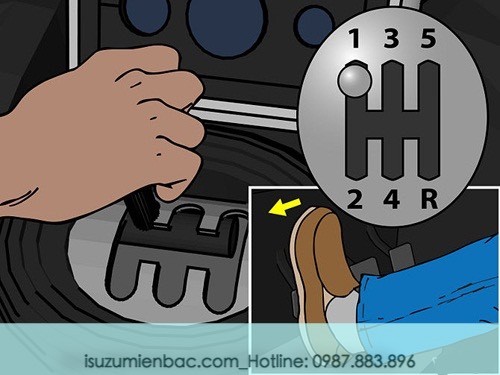 Techniques for driving a manual transmission truck
Techniques for driving a manual transmission truck
Detailed instructions for manual gear shifting:
- Step 1: Fully depress the clutch pedal (left foot). The right hand gently shakes the gear shift to ensure that the gear shift is in the O (Mo) position.
- Step 2: Turn the key to start the vehicle. Hold the clutch pedal and lightly press the accelerator pedal to make the engine run smoothly.
- Step 3: Move the right foot from the accelerator pedal to the brake pedal, release the parking brake.
- Step 4: Shift into 1st gear. Lift the right foot off the brake pedal and switch to the accelerator pedal. Slowly release the clutch pedal to about 1/3 of its travel and simultaneously lightly press the accelerator pedal.
- Step 5: When the vehicle starts to roll, continue to fully release the clutch pedal and gradually increase the throttle to accelerate. Then, do the same to shift to the next gears.
Notes when shifting gears in a manual Isuzu truck:
- Always fully depress the clutch pedal when shifting gears to avoid damaging the transmission.
- Coordinate the clutch pedal and accelerator pedal smoothly to make the vehicle run smoothly.
- Do not “force gears” (shift into a high gear when the vehicle’s speed is not sufficient), causing engine lugging and fuel consumption.
- Select the appropriate gear for the speed and terrain to ensure performance and safety.
Correlation between gear and speed (for reference):
- 1st gear: 5-10 km/h
- 2nd gear: 10-15 km/h
- 3rd gear: 15-30 km/h
- 4th gear: 35-40 km/h
- 5th gear (or higher): Over 45 km/h
Maintaining the Isuzu Truck Gear Shift Knob for Durability
To keep the Isuzu truck gear shift knob durable and ensure the best driving experience, you should apply the following maintenance measures:
1. Use an Isuzu Truck Gear Shift Cover
The gear shift cover not only enhances the aesthetics of the vehicle’s interior but also protects the gear shift knob from scratches and peeling caused by hand sweat and environmental impacts.
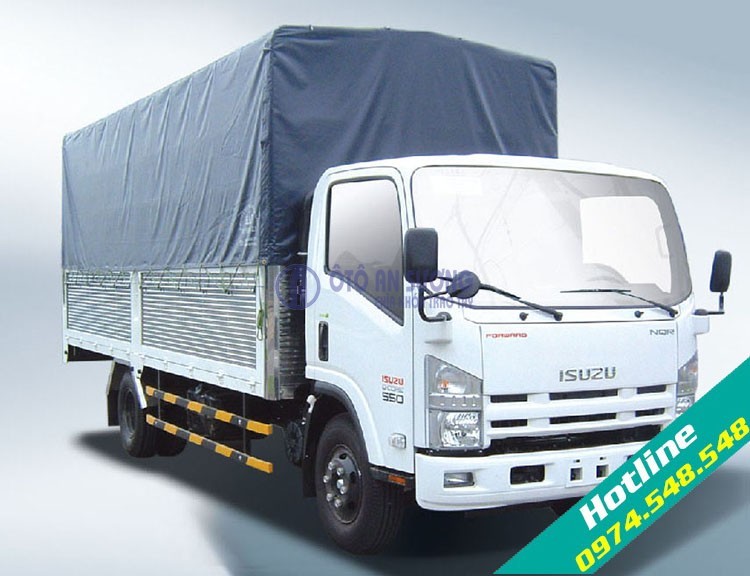 Leather gear shift cover for an Isuzu truck
Leather gear shift cover for an Isuzu truck
Benefits of using a gear shift cover:
- Protection: Prevents scratches, fading, and cracks on the gear shift knob.
- Aesthetics: Enhances the beauty and luxury of the vehicle’s interior.
- Comfort: Creates a smooth and secure grip, reducing hand numbness when driving long distances.
- Safety: Gear shift covers made of leather or non-slip materials help increase grip, preventing slippage due to hand sweat, especially important in hot and humid weather conditions.
2. Clean the Gear Shift Knob Regularly and Correctly
The gear shift knob is in direct contact with the driver’s hands every day, so it is prone to dirt, sweat, and bacteria. Cleaning the gear shift regularly helps ensure hygiene, increase durability, and maintain the beauty of the gear shift knob.
How to clean the gear shift:
- Use a soft, damp cloth to wipe the surface of the gear shift.
- You can use a diluted specialized interior cleaning solution to clean stubborn stains.
- Avoid using harsh detergents or corrosive chemicals that can damage the material of the gear shift knob.
- For leather gear shift covers, use specialized leather care products to keep the leather soft and colorfast.
3. Handle Problems Promptly When Detecting Abnormal Signs
Regularly checking and paying attention to abnormal signs in the Isuzu truck’s gear shift is the best way to detect problems early and take timely measures to avoid causing more serious damage and ensure safety during operation.
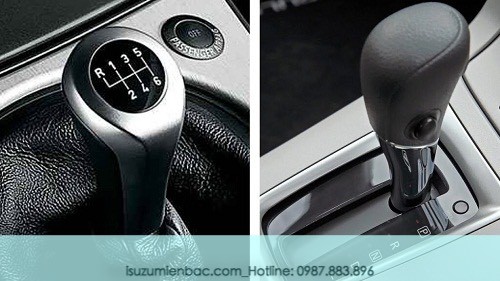 Periodic inspection of an Isuzu truck gear shift
Periodic inspection of an Isuzu truck gear shift
Abnormal signs to watch out for:
- Oil leaks: If you notice oil leaking around the gear shift lever, it may be due to aged or damaged oil seals. Take the vehicle to a garage to check and replace the oil seals in a timely manner.
- Difficult operation: A stiff gear shift, difficulty shifting gears, or strange noises when shifting gears can be a sign of problems inside the transmission or drivetrain.
- Cracks, physical damage: If you find the gear shift knob is cracked or physically damaged, it needs to be replaced to ensure safety and aesthetics.
Conclusion:
Understanding the Isuzu truck gear shift, from the meaning of the symbols to how to use and maintain it, is essential knowledge for all Isuzu truck drivers. We hope this article from Xe Tải Mỹ Đình has provided you with useful information and helps you feel more confident on every journey. If you have any questions or need advice on Isuzu trucks, don’t hesitate to contact us for the best support.
